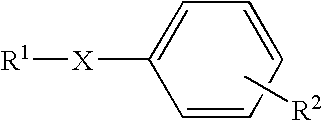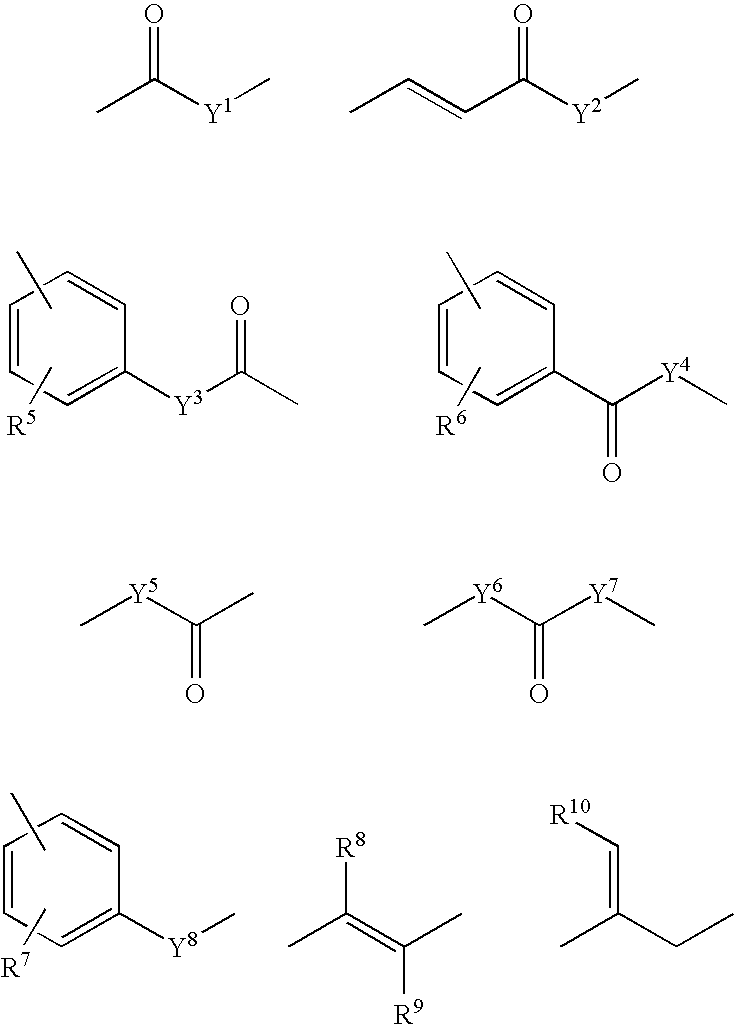Dicarba-closo-dodecaborane derivatives
a technology of dicarbaclosododecaboran and derivatives, which is applied in the direction of group 3/13 element organic compounds, immunological disorders, metabolism disorders, etc., can solve the problems of conventional studies far from drug designs, and achieve superior therapeutic effects and activity. superior
- Summary
- Abstract
- Description
- Claims
- Application Information
AI Technical Summary
Benefits of technology
Problems solved by technology
Method used
Image
Examples
example 1
1,2-dicarba-closo-dodecaborane-1-carboxylic acid (100 mg, 0.531 mmol) was dissolved in dichlorometbane (1 ml), and oxalyl chloride (101 mg, 0.795 mmol) and catalytic amount of dimethyl formamide (DMF, one drop) were added, and the mixture was stirred at room temperature for 3 h. Then the reaction mixture was concentrated. The residue and methyl 4-aminobenzoate (80.3 mg, 0.531 mmol) were suspended in dichloromethane (2 ml), 4-dimethylaminopyridine (130 mg, 1.06 mmol) was added at 0° C., stirred at room temperature for 1 h under argon atmosphere. The reaction was quenched by the addition of 2N hydrochloric acid, and the mixture was extracted with dichloromethane. The organic layer was washed with water, saturated sodium hydrogencarbonate solution, water, and brine in order, and dried over sodium sulfate and concentrated. The residue was purified by silica gel flash column chromatography (eluent: hexane / ethylacetate=5 / 1) to give methyl 4-[(1,2-dicarba-closo-dodecaboran-1-yl)carbamoyl]b...
example 2
Ethynyltrimethylsilane (5.0 g, 50.9 mmol) was dissolved in dry diethyl ether (50 ml), 1.6 M n-butyllithium in hexane(35.0 ml, 56.0 mmol) was added dropwise at 0° C. under argon atmosphere. The mixture was stirred at the same temperature for 1 h. DMF(3.72 g, 50.9 mmol) was dissolved in diethyl ether (20 ml), and was added dropwise below 5° C. for 30 min, then the mixture was stirred at room temperature for 2 h. The reaction was quenched by the addition of 2N hydrochloric acid, and the mixture was extracted with diethyl ether. The organic layer was washed with water, saturated sodium hydrogencarbonate solution, and brine in order, and dried over sodium sulfate. Purification by distillation (40-45° C. / 15 mmHg) gave 3-(trimethylsilyl)propiol aldehyde (28%).
Colorless oil
1H-NMR (CDCl3) δ:0.27 (9H, s), 9.17 (1H, s).
To a suspension of sodium hydride (556 mg, 13.9 mmol) in THF (7 ml), diethyl phosphonoethyl acetate (3.12 g, 13.9 mmol) in THF (7 ml) was added dropwise under argon atmosphere. ...
example 3
A mixture of ethenylbenzene (5.51 g, 53.9 mmol) and decaborane (14)(2.64 g, 21.6 mmol) in acetonitrile (5.5 ml) and benzene (55 ml) was refluxed for 4 days under argon atmosphere. Then the mixture was concentrated, it was purified by silica gel column chromatography (eluent: hexane) to give 1-phenyl-1,2-dicarba-closo-dodecaborane(74%).
Colorless prisms (hexane)
m.p.: 66-67° C.
1H-NMR (CDCl3) δ:1.50-3.50 (10H, br m), 3.97 (1H, br s), 7.33 (2H, m), 7.39 (1H, m), 7.49 (2H, m).
1-Phenyl-1,2-dicarba-closo-dodecaborane(950 mg, 4.31 mmol) was dissolved in dry diethylether (15 ml), 1.54M n-butyl lithium in hexane solution(2.8 ml, 4.31 mmol) was added dropwise at 0° C. under argon atmosphere. After the mixture was stirred at room temperature for 3 h, it was cooled to −78° C. Methyl iodide (673 mg, 4.74 mmol) in THF(3 ml) was added dropwise, and further stirred at room temperature for 16 h. The reaction was quenched by the addition of 2N hydrochloric acid, and the mixture was extracted with dieth...
PUM
| Property | Measurement | Unit |
|---|---|---|
| Molar density | aaaaa | aaaaa |
| Molar density | aaaaa | aaaaa |
| Molar density | aaaaa | aaaaa |
Abstract
Description
Claims
Application Information
 Login to View More
Login to View More - R&D
- Intellectual Property
- Life Sciences
- Materials
- Tech Scout
- Unparalleled Data Quality
- Higher Quality Content
- 60% Fewer Hallucinations
Browse by: Latest US Patents, China's latest patents, Technical Efficacy Thesaurus, Application Domain, Technology Topic, Popular Technical Reports.
© 2025 PatSnap. All rights reserved.Legal|Privacy policy|Modern Slavery Act Transparency Statement|Sitemap|About US| Contact US: help@patsnap.com



